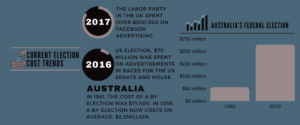Biggest Election Costs Around the World

Many political candidates spend mass amounts of money on their campaign. With large spending, comes greater exposure and coverage. In modern society, with technological advances, election costs around the world are growing.
- In 2016, Hillary Clinton’s presidential campaign cost $1.4 billion. (Washington Post).
- Donald Trump spend $957.6 million on his presidential campaign in 2016. (Washington Post).
- The 2017 United Kingdom snap general election cost $140 million.
- United Australia Party’s, Clive Palmer has spent over $27 million on advertising since September 2018.
- India has the biggest elections, with 800 million eligible votes. (Interative Aljazeera).
- Coming in second, Indonesia has 187 million eligible voters. (Interative Aljazeera).
As a foundation of democracy, voting in elections has been adopted in most countries around the world. Whilst the process of electing an individual as a representative in your government can be simple, many election candidates spend mass amounts of money on their campaigns. Here, we explore the impact of election costs, the trends of election costs, and election costs around the world.
Current Election Cost Trends

The past decade has seen a consistent trend of politicians and election candidate spending more and more on their campaigns. Higher household incomes, inflation and population growth are all factors that have contributed to this trend of higher election spend. However, removing these mitigating factors, technological advances and the rise of social media are the two significant reasons why election costs are increasing.
- Data from the Australian Electoral Commission showed that Australia’s federal election in 1990 cost $55 million. In 2019, Australia’s federal election cost $227 million. (Election Watch).
- In the 2016 US election, $70 million was spent on advertisements in races for the US Senate and House. (The Conversation).
- In 1981, the cost of a by-election was $71,000. In 2018, a by-election now costs on average, $2.2million. (Australian Electoral Commission).
- The Labor party in the UK spent over $500,000 on Facebook advertising in their 2017 election.
Voting Statistics Around the World

Every country around the world has different rules and regulations when it come sot voting in elections. The biggest differences amongst most major countries is, the age in which an individual may vote and whether voting in an election is compulsory or not.
- Argentina, Brazil and Austria are among the few countries where the legal voting age is 16. (Interative Aljazeera).
- Two countries where the voting is 21 are Singapore and Malaysia. (Interative Aljazeera).
- In New Zealand, those who are imprisoned cannot vote. (Interative Aljazeera).
- Enrolling and voting in an election is compulsory in Australia, Belgium, Singapore, Brazil and more. (Wikipedia).
- In the United States and the United Kingdom, there is no legal requirement to vote. (Brit Politics).
Impact of Election Costs

Funds and spending can impact the way an election candidate runs. Early money, or money raised before the primary can have a significant impact on the workings of an election campaign. Earning big donations allows candidates to build a campaign structure. It allows greater freedom in spending on advertisement and exposure. However, whilst money has a significant impact on election campaigns, it is not a final determining factor in winning or losing an election.
- Donald Trump spent US$7million over the first six months of his presidential campaign, compared to the US$1million spent by Barack Obama in 2010. (Business Insider).
- A total of US$83,700 was spent on Facebook Advertising by Donald Trump in 2016. (Business Insider).
- The Australian Liberal Party has spent $2.1milion on advertising for the upcoming election. (AD News).
- Similarly, the Australian Labor Party has spent $2.3million on advertising for the upcoming election.
Predictions for Future Election Costs

Global Trends show that the costs of elections are rising significantly. This trend is predicted to grow as household incomes and the population of the world grow. Access to information is easily accessible via the internet and this has led to more politicians and political parties to spend their funds on these platforms for advertising and exposure.
- It is predicted that this trend of spending an increasing amount of funds on advertising and social media will continue to grow.
- Political revenue in the US will most likely grow more than 50% since the last midterm election in 2014. (EMarketer).
- It is predicted that the 2020 US presidential election will be the most expensive election to date. (Voa News).






